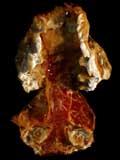Bigger, cleaner, more specifically
2006/05/04 Rementeria Argote, Nagore - Elhuyar Zientziaren Komunikazioa

They say it is the most accurate microscope that has been developed so far. It is based on X-ray microtomography, as well as other microscopes, but it obtains larger, cleaner images.
To do this, they have added a new technique: ‘time delay integration’. This technique corrects the imperfections of the three-dimensional images obtained by X-rays gradually.
This microscope has been developed by teams from six British universities. And they have published as proof spectacular images as the one above. It is the palate of a carnivorous mammal who lived forty and fifteen million years ago, Viverravus acutus.
This image shows that it will be a very useful tool for paleontologists. However, they have emphasized that they also use it in other fields of research and that applications can become a thousand, for example, for the realization of diagnoses in bones and teeth, to know the behavior of metals at microscopic level, etc.




